I. What is Cellular Membrane Composition and Structure?
If you’re thinking about the cellular membrane as the castle wall of the cell, you’re on the right track! To give a real world analogy, the cellular membranes of prokaryotic and eukaryotic cells serve the same role as the Great Wall of China many centuries ago!
Though it’s a little deceiving to call them a wall (as there is a separate cell wall organelle that is only present in prokaryotes), the cell membrane does have a similar purpose in acting as the eukaryotic cell border and is highly important for cellular function.
Being essentially the first thing an outside particle, molecule, or agent comes in contact with when approaching a cell, it’s no wonder that the cell membrane is involved in many cellular functions including cell signaling, protecting, cell shape integrity, etc.
II. Composition of the Cell Membrane
If we were only allowed one sentence to cover this cell membrane section, it definitely would be characterizing the cellular membrane as a phospholipid bilayer. From this simple fact comes all the other content that covers these articles. Let’s break down the phrase:
A. Phospholipid Bilayer
Phospholipids are the most prominent component of the cell membrane, outside of proteins. Given their name, they are composed of a phosphate group & 2 fatty acids tails. The membrane is also bilayered, meaning there are 2 layers which compose the membrane.

Notice how in the bilayered membrane, the phospholipids are oriented where the fatty acid tails are interacting with each other on the inside and the phosphate head groups are facing the outside. This is important when later discussing the important intermolecular interactions.
B. Cellular Membrane Components
There are numerous cell membrane components but will primarily focus on three: 1) phospholipids, 2) proteins, and 3) cholesterol.
This is not to say that other components aren’t important, such as carbohydrates and waxes, as they have their own important functions within the cell membrane. However, we want to focus on these 3 main ones!
I. Phospholipids
Let’s further expand on phospholipid structure!! The most prominent type of phospholipid is a glycerophospholipid, which contains a glycerol backbone.
Because glycerol has 3 hydroxyl groups present, a phosphate group and the 2 fatty acids can be attached to glycerol via esterification.
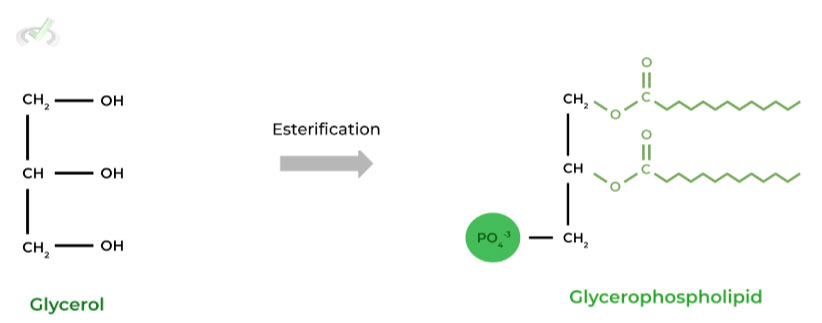
Another important term to describe phospholipids are amphipathic, meaning they have both hydrophilic and hydrophobic properties which arise from the phosphate group and fatty acid tails, respectively.
II. Proteins
The cell membrane proteins can be categorized into 2 main subdivisions: 1) integral proteins and 2) peripheral proteins. Furthermore, integral proteins can be divided into whether they’re transmembrane or embedded.
The main differences between the categorizations are the locations of the proteins within the membrane. Look to the diagram below for more detail!
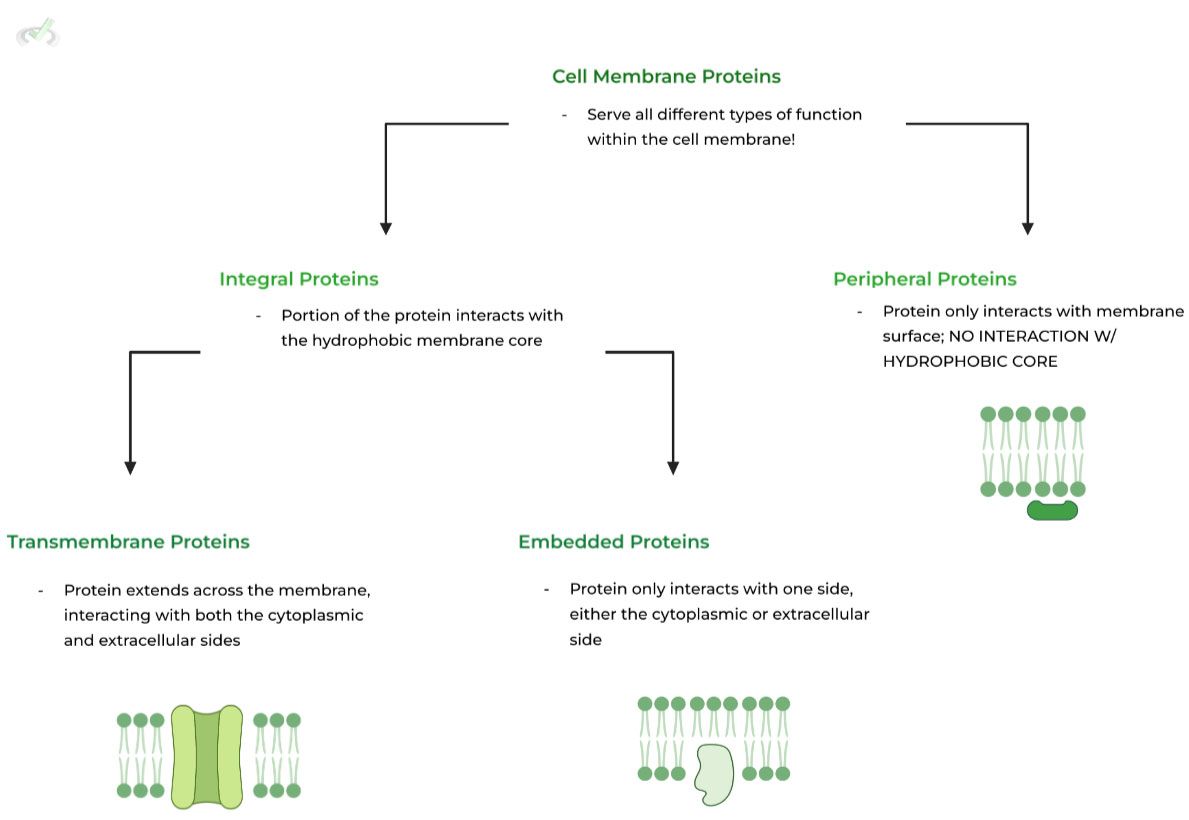
Pay special note to the interactions! Integral proteins have interactions with both the hydrophobic core and hydrophilic environment while peripheral proteins are only associated with the phosphate heads on the membrane surface.
Consider the type of interactions that are favorable in terms of what amino acids can be placed. This is often how the MCAT will test these concepts!
Proteins have numerous functions in the cell membrane, from being receptors, ion channels, and even enzymes, acting as a bridge between the extra and intracellular environments.III. Cholesterol
Though we’re often told to cut down on foods high with this molecule, it actually plays an important structural role in the cell membrane!
Funny enough, as it’s usually associated with hydrophobicity, cholesterol also has partial hydrophilic character, due to the attached hydroxyl group!

When placed in the membrane, it orients similarly to the phospholipids, with the hydroxyl facing outward and the hydrophobic ring structure facing inwards. We’ll talk more about cholesterol’s role in membrane fluidity in another article!
C. Cellular Membrane Junctions
As their name suggests, cell junctions concern the protein connections between cells on the cell membrane. These cellular connections have function in cell to cell communication and/or structural integrity. Take a look at the main ones below!
I. Gap Junctions
Think of these as channel proteins but between proteins! This channel allows for instant flow of molecules between cells often needed for instant cell communication!
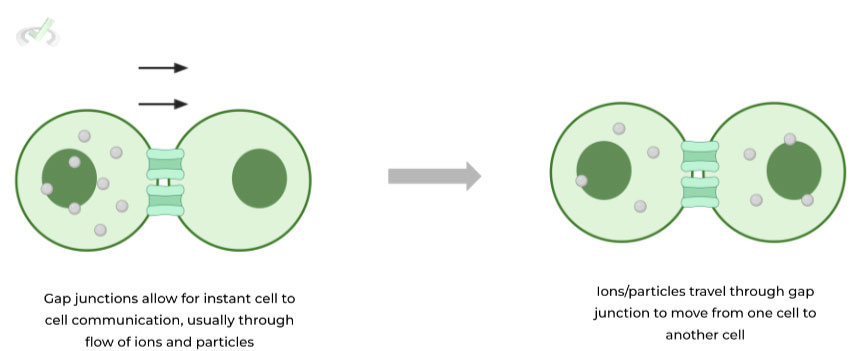
One common example of cell junctions are the intercalated discs located within the cardiomyocytes.
In order for the cardiac muscle to depolarize together, the cardiomyocytes have intercalated discs in order for the depolarizing ions to travel between cells, causing a “spread” or “wave” of depolarization.
II. Tight Junctions
In this case, the protein connections made between cells are strong and rigid, so as to prevent the passage of unwanted particles between cells.
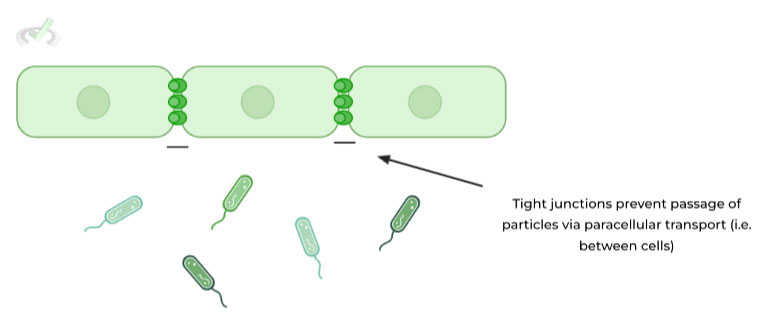
A great example of tight junctions is within the epithelial lining of the intestines. This makes sense because we wouldn’t want potentially harmful agents, such as bacteria, entering into the bloodstream and causing a problematic immune response!
III. Desmosomes
Likewise, these junctions form strong connections between cells while also binding and serving as an anchoring point for intermediate filaments. In this way, the intermediate filaments between cells are connected as well, with the desmosomes acting as a bridge.
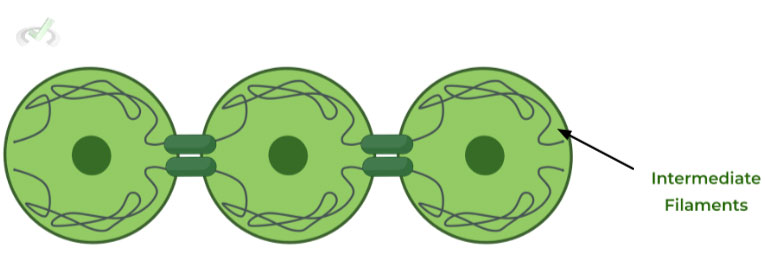
This interconnection of intermediate filaments is important for giving strength to the cells especially those under heavy mechanical stress. Can you guys think of some areas that would be high in desmosome cell junctions?
III. Bridge/Overlap
The formation of the cell membrane’s orientation of its phospholipid bilayer can very well be explained by general chemistry concepts, including favorable intermolecular interactions as well as thermodynamics.
I. Intermolecular Interactions and Thermodynamics
An important idea to realize is that the extracellular and intracellular environments are highly hydrophilic and polar. This fact really drives the orientation formation of the cell membrane.
The hydrophobic effect describes the tendency for nonpolar moieties to associate with each other, in order to prevent interactions with polar, hydrophilic substances, a SPONTANEOUS process because it aims to get the system into a lower state of energy.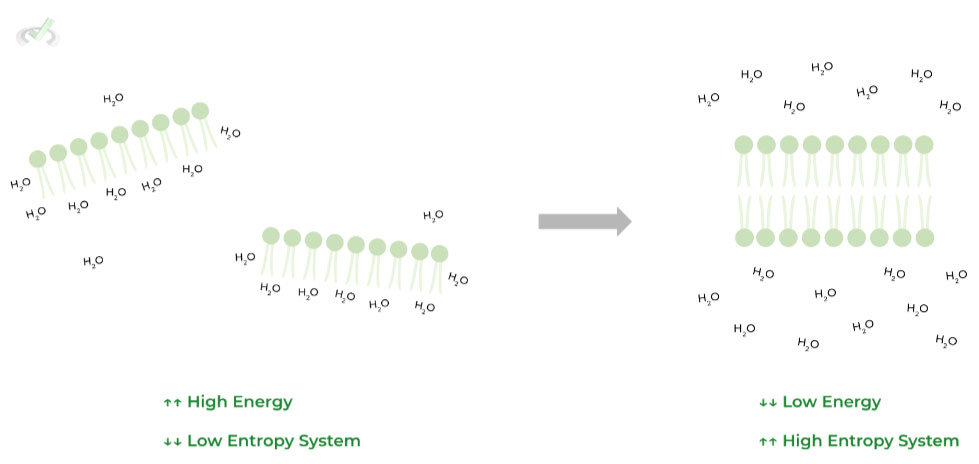
Think about this through entropy! Water molecules tend to engulf nonpolar entities when exposed, DECREASING the water’s entropy & interactions with each other.
However, with phosphate groups interacting with the polar extra & intracellular sides, the water molecules are less restricted in movement and are more free to move and interact, INCREASING entropy!
IV. Wrap Up/Key Terms
Let’s take this time to wrap up & concisely summarize what we covered above in the article!
A. Phospholipid Bilayer
The cell membrane is characterized as having a phospholipid bilayer, where there are 2 membrane layers of phospholipids arranged where the fatty acid tails are facing inward creating a hydrophobic core and the phosphate heads face the polar extracellular & intracellular environment.
It’s thanks to the amphipathic characteristics of the phospholipids that the cell membrane can form spontaneously, reducing the energy and increasing the entropy of the system!
B. Cellular Membrane Components
While there are various components of the cell membrane, the 3 main ones we want to focus on are 1) phospholipids, 2) proteins, and 3) cholesterol.
I. Phospholipids:
The most prominent phospholipids in the cell membrane are glycerophospholipids, which contain 2 hydrophobic fatty acid tails and 1 polar phosphate head attached to a glycerol backbone.
II. Proteins:
Can be divided into 1) integral proteins and 2) peripheral proteins. Integral proteins have interactions with the hydrophobic core while peripheral proteins only interact with the phosphate heads on the cell surface.
Integral proteins can also be divided into transmembrane & embedded: transmembrane proteins protrude through the membrane interacting with both the extra & intracellular side while embedded proteins only interact with one side.III. Cholesterol:
Because of the hydroxyl group on its structure, cholesterol aligns similarly to how phospholipids orient themselves in the membrane. It also has important implications when it comes to regulating membrane fluidity.
C. Cellular Membrane Junctions
Concerns the protein connections made between cells with function involving cell communication and/or structural integrity. The 3 main cell junctions are: 1) gap junctions, 2) tight junctions, and 3) desmosomes.
I. Gap Junctions:
Think of these as essentially channel proteins between the cells! This is utilized in order for instant cell communication via the instant passage of ions/particles between cells!
II. Tight Junctions:
These connections are very rigid and tight between cells so as to prevent the passage of unwanted particles and agents between cells!
III. Desmosomes:
While connecting neighboring cells, they also serve as attachment points for the cell’s intermediate filaments. In a way, a group of cells also have their intermediate filaments connected, which aids to maintain structural integrity in areas of high mechanical stress!
V. Practice
Take a look at these practice questions to see and solidify your understanding!
Sample Practice Question 1
Which of the following can be characterized as amphipathic?
I. Transmembrane Protein
II. Phospholipid
III. Cholesterol
A. I only
B. III only
C. I and III
D. I, II, and III
Ans. D
Amphipathic is a term used to describe a molecule that has both hydrophilic and hydrophobic portions in their structure. Phospholipids have a hydrophilic phosphate head and hydrophobic fatty acid tails. Cholesterol has a hydrophilic hydroxyl group and a hydrophobic ring structure.
The transmembrane protein also is amphipathic because it interacts with both the hydrophilic extra/intracellular sides as well as the hydrophobic core. Because of this, it should also have a hydrophobic portion interacting with the core and a hydrophilic portion interacting with the sides!
Sample Practice Question 2
Cytokines and interferons are important molecules that are involved in the inflammatory response, especially under viral infection. As such, cytokines produced by one cell will need to communicate and interact with neighboring cells in order to prepare their defenses against viral infection. What type of cell junction would these cells utilize?
A. Tight Junctions
B. Gap Junctions
C. Desmosomes
D. Hemidesmosomes
Ans. B
Gap junctions are cellular protein connections, often channel proteins, that allow cells to communicate with one another via the instant flux of particles and molecules. Gap junctions would be expected to participate in the inflammatory response as the neighboring cells can communicate instantly with one another via the gap junctions.
The cytokines and interferons would flow between cells via gap junctions, allowing for the priming of neighboring cells for viral defense and the inflammatory response.



 To help you achieve your goal MCAT score, we take turns hosting these
To help you achieve your goal MCAT score, we take turns hosting these 
























